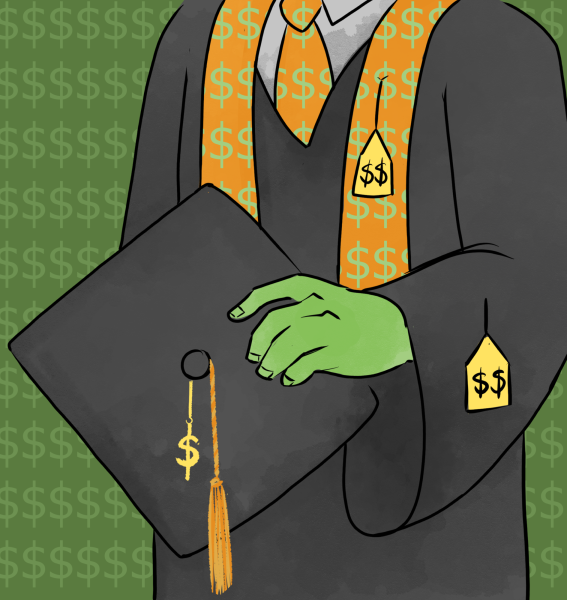Clairmont: OSU athletics fails to enforce student mask policies
This illustration is meant to represent students who are wearing their masks during home beaver games at Reser Stadium. While the Oregon State University requires masks to be worn in outdoor spaces where physical distancing is not possible, some students have taken off their masks in Reser Stadium during football games.
October 1, 2021
Editor’s Note: This column does not represent the opinion of The Daily Barometer. This column reflects the personal opinions of the writer.
Oregon State University’s lack of mask enforcement at outdoor athletic events allows students to dangerously convene without masks or social distancing.
While the statewide outdoor mask mandate was placed into effect on Aug. 24, getting numerous communities to continue to comply with these standards can be difficult simply due to a lack of means.
During OSU’s last two home football games, many audience members in the student section at Reser Stadium could be seen standing shoulder-to-shoulder and maskless despite Oregon’s current mask mandate.
For some students and faculty members, this mass gathering of maskless students is worrisome. For others, the mandate is outdated and impossible to enforce in large spaces without substantial funding for staffing.
Dan Bartholomae, OSU’s executive deputy athletic director, feels their department is doing all it can to comply with these standards.
“We have met weekly with public health officials in Benton County since summer of 2020 and closely study the mandates imposed at the state level in regards to events on campus,” Bartholomae said. “We appreciate and respect their advice on the public health protocols appropriate for outdoor events.”
However, respecting and enforcing protocols are very different matters. What good are all of these meetings if we can’t as a university actually carry out the discussed mission?
There is nobody to blame. Never before has enforcing such a mandate been part of anyone’s job description. Ensuring customers are in compliance with such rules can be intimidating, to say the least.
Are university employees getting paid enough to bear this burden? There is certainly a lack of funding to enforce this mandate in situations where an entire crowd of people is in defiance. And even if there was funding for a mandating project, would it be plausible?
“As you can imagine, the mask mandate in an outdoor setting with food and beverage is difficult to enforce,” Bartholomae said. “That difficulty is compounded by the fact that Oregon is one of only two states with such a mandate.”
With students coming from all over the country, the state laws enforced in their home states are bound to be different from those in Oregon. Employees are not equipped to take on such an uphill battle without reinforcements.
For Bartholomae, requiring all fans to be masked upon entry and providing masks at all entrances for fans who forget to bring one are two strategies helping them enforce the mandate, but they are not a cure-all.
Additionally, public health experts aren’t so sure the maskless gatherings are as safe as students believe them to be, with vaccine immunity waning and the COVID-19 Delta variant circulating.
“I am a little bit concerned,” Chunhuei Chi, the director of the Center for Global Health, said. “The masking [is] necessary particularly during Oregon’s high peak. The cases, hopefully, in the next month or two will decline. And if the cases decline to a much lower level, then I am less concerned about masking in sports events.”
Chi feels the issue of enforcing masks at athletic events is difficult to solve since he understands that students are tired of wearing masks.
Nevertheless, he wants students to know wearing masks will be temporary and everyone needs to participate to maintain the OSU campus and keep the community safe.
“Knowing that there [is] still some risk of infection, we don’t want infections to happen when our classes have already started because if one class has one student [who] confirms infection, that class will have to be suspended; become remote for a week or two—because those people are urged to do some level of self-quarantine,” Chi said.
We all want to return to normal, but Oregon’s COVID-19 case count is at its largest peak yet, reaching 326,191 total cases on Sept. 28. Breakthrough infections continue to be a cause for concern when transmission rates are high.
OSU staff members do not have the resources they need to ensure students mask up at large scale events, but students should revisit this issue and really think about the repercussions of their decisions.
If we want OSU’s campus and athletic events to stay open to the public, wearing masks is an important tool to help us sustain that goal.






















































































































